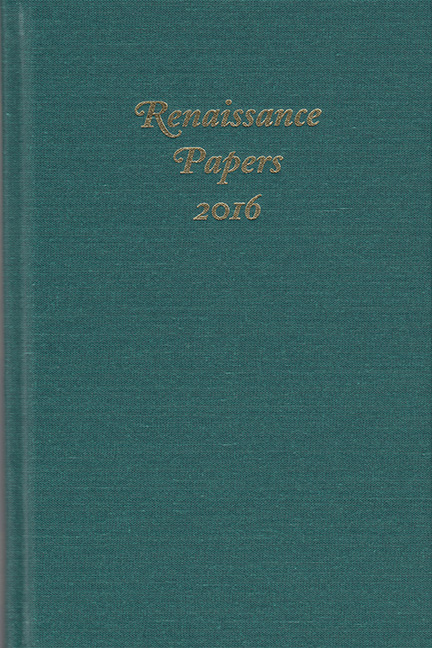Book contents
- Frontmatter
- Contents
- Renaissance Papers
- Beyond Recognition: Mutilation, Marginalia, and the Vicissitudes of Reading
- Velázquez as Reader and the Pictor Doctus in Early Modern Spanish Art
- “Out of this silence yet I picked a welcome”: The Audience in A Midsummer Night's Dream
- Uncommon Justice: The Secret Knowledge and Sagacious Judgment of Old Escalus
- Boundaries in a Globalized World: Shakespeare's Antony and Cleopatra
- Imitation, Innovation, and Imperium: The Grammar School Education of Lear's Daughters
- Violent Brothers, Deadly Antifeminism, and Social Suicide in The Revenger's Tragedy and The Duchess of Malfi
- Canon Fodder: Notes on Don Quijote
Beyond Recognition: Mutilation, Marginalia, and the Vicissitudes of Reading
Published online by Cambridge University Press: 23 August 2019
- Frontmatter
- Contents
- Renaissance Papers
- Beyond Recognition: Mutilation, Marginalia, and the Vicissitudes of Reading
- Velázquez as Reader and the Pictor Doctus in Early Modern Spanish Art
- “Out of this silence yet I picked a welcome”: The Audience in A Midsummer Night's Dream
- Uncommon Justice: The Secret Knowledge and Sagacious Judgment of Old Escalus
- Boundaries in a Globalized World: Shakespeare's Antony and Cleopatra
- Imitation, Innovation, and Imperium: The Grammar School Education of Lear's Daughters
- Violent Brothers, Deadly Antifeminism, and Social Suicide in The Revenger's Tragedy and The Duchess of Malfi
- Canon Fodder: Notes on Don Quijote
Summary
The reading of this play is like wandering in a grove by moonlight, and the descriptions breathe a sweetness like odours thrown from beds of flowers.
—William HazlittFor graves have learn'd that woman-head, To be to more than one a bed—
—John Donne, “The Relic”WHILE no two objects can occupy the same space at the same time, books, like graves, have a long history, as Donne describes it, of being “to more than one a bed.” Over time, scribal hands or printed texts come to coincide with individual inscriptions and marginalia, incorporating disparate times, places, and subjectivities within the book's inviting leaves. In these fields of materialized memory, discrete moments of engagement are preserved: the remains of reading as a lived experience of temporality, materiality, and recursive thought. Thus, the vicissitudes of reading, those instances of realization and change that characterize the cognitive act itself, shade into the frisson of recognition, a re-experiencing of something previously known. These coincident structures of signification invite “coincidental” structures of reading, raising questions about not only what we read but also how we may read it. Other physical features—bindings, damaged or missing pages, stray marks, or willful mutilation—also become recognizable features, constituting part of a given book's reading “matter.” Writing of the early modern commonplace book, Robert Darnton argues that reading and writing “belonged to a continuous effort to make sense of things, for the world was full of signs: you could read your way through it; and by keeping an account of your readings, you made a book of your own, one stamped with your personality.”
Examining mutilation and marginalia as opposed impulses that converge in the association of the material with the nominal, this essay explores questions of reading and recognition in the Durham First Folio, the prayer book of Lady Jane Grey, and a copy of Shakespeare's dramatic works mutually annotated by George Eliot and George Henry Lewes. In each of these instances an artifact aligns with identity, defining their association with one another in terms of the relationship to reading it occasions. For the Durham Folio, such association highlights the book as a commodity whose economic value is underwritten by the cultural capital of Shakespeare's name.
- Type
- Chapter
- Information
- Renaissance Papers 2016 , pp. 1 - 14Publisher: Boydell & BrewerPrint publication year: 2017

